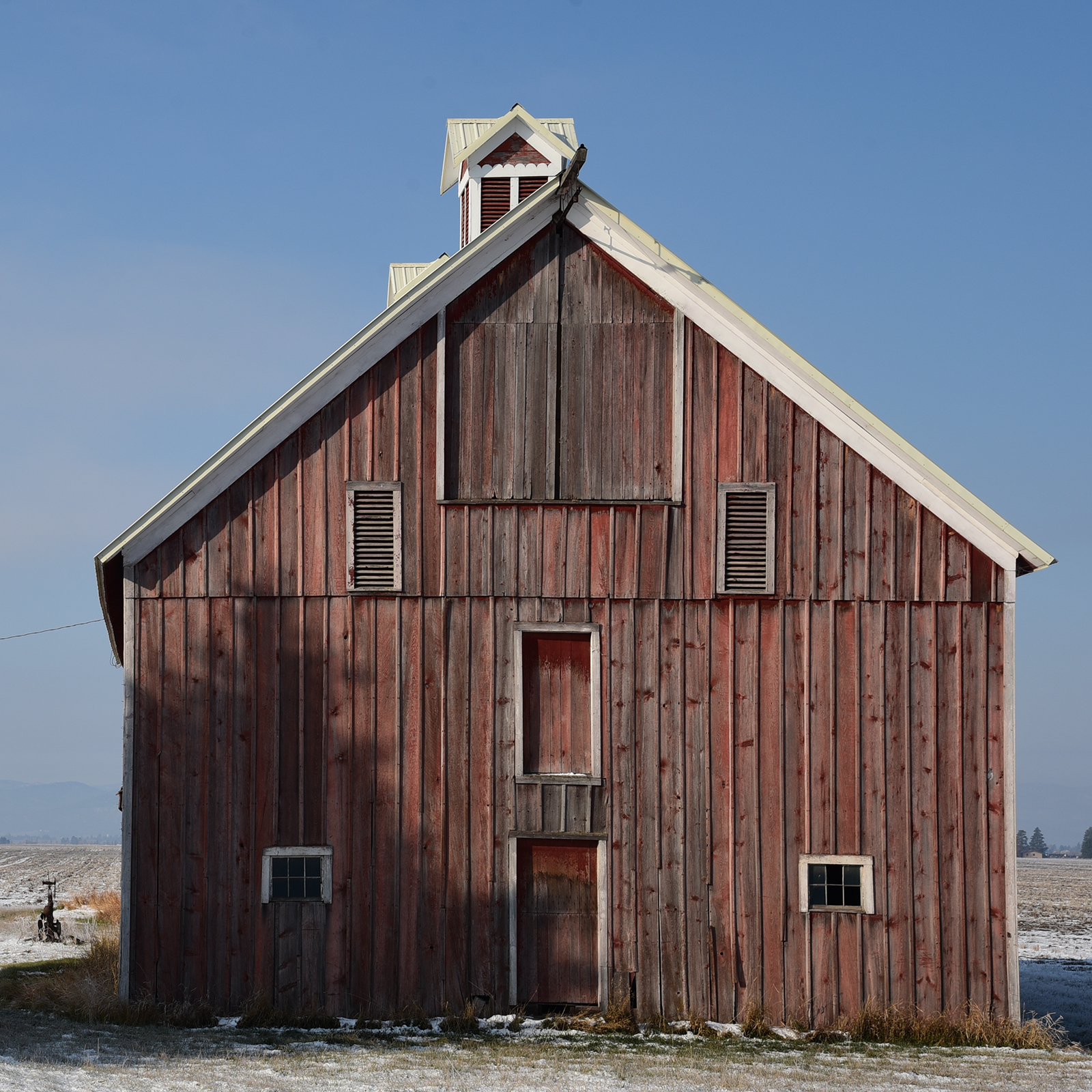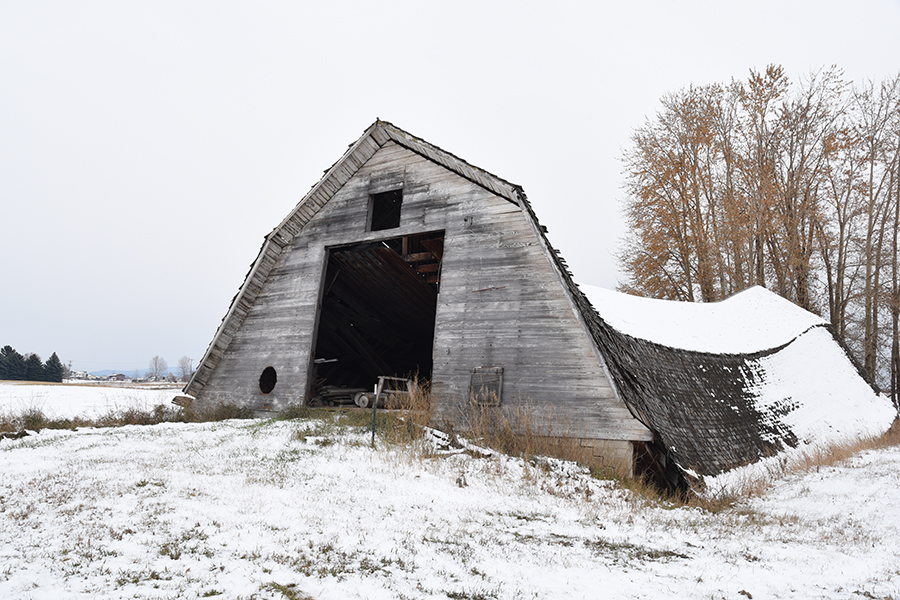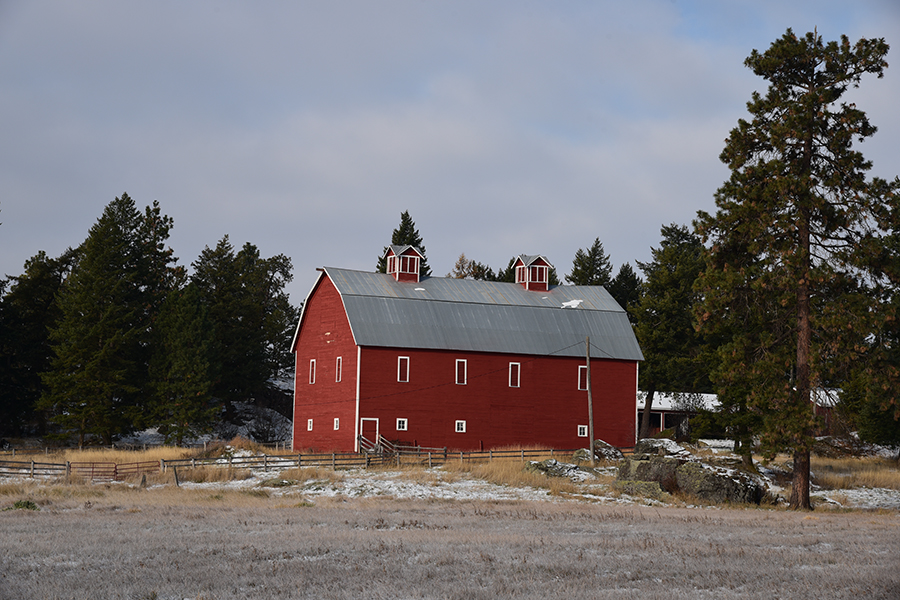
Driving Highway 82, which runs between Somers and Bigfork in the lower Flathead Valley, is for many a daily ritual. Rushing to work, getting kids to school, hauling groceries.
Before highways and motorcars, early Lower Valley settlers — folks like the Oldenburgs, the McClartys and the Porters — created lives reliant on rich soil, hard work and a good team of horses.
More than a century later, a fair portion of this scenic chunk of the Flathead is still farmed. But on both sides of the highway sit historic barns — some regal, some forlorn — the handcrafted remnants of those less hurried lives.
“They are honest buildings and they are part of a family history,” says Chere Jiusto, executive director of the Montana Preservation Alliance, explaining the allure of what she calls “heritage” barns. “People just feel an attachment to the story of these barns.”
A few years back, the Montana Preservation Alliance and the Montana Historical Society teamed up to produce Hand Raised: The Barns of Montana, a book that tells the story of about 140 historic barns across Montana, including some of the many Flathead Valley gems. A state agricultural census about a decade ago put the number of historic barns in Montana at nearly 6,000. While plentiful and an “essential part of our cultural landscape,” Jiusto and others say old barns are among the most threatened historical structures in the state.
Many of the barns were built between 1880 and 1920. While some have seen preservation work, others are losing the battle with time and the elements. Expensive to maintain, many of these old barns have lost a functional purpose. Modern farms and ranches rely less on horses, dairy farms are disappearing, and the machines that power today’s agricultural operations fit better in newer metal structures than in a century-old wooden barn.

Historic barns dot western Montana and the Flathead. While not as visible as those in the Lower Valley and Creston areas, there are number of great old barns in the area northwest of Kalispell as well as near Whitefish and Columbia Falls.
The stories of the barns are tales of despair and good fortune that have played out in glowing red, sparkling white or, more often, weathered shades of gray.
One classic Flathead barn, built south of Kalispell by Ole and Emil Mellem in 1913, is essentially a billboard for a recreational vehicle dealership along four-lane Highway 93.
For decades, the Fredenberg family grew seed potatoes off Whitefish Stage Road, and livestock found feed and refuge in a barn on the property. Megan and Scott Lester purchased the 65-acre farm about five or six years ago, with plans for a rural home but little vision for the barn.
Today, the couple is operating an organic vegetable farm, and the barn, with an updated electrical system but few other changes, is home to an assemblage of critters, including goats, sheep, horses and peacocks.
“It’s really a neat old barn,” Megan Lester says. “I love it. It adds a lot of character to the property.”
South of Kalispell, the Porter/Blasdel barn entered life in grand fashion. Constructed by valley pioneer Frank Porter in 1908, progress on the barn, tabbed “the largest in the entire valley,” was chronicled in the daily newspaper. A party held at its completion featured two bands and drew attendees from all over the Flathead.

The 95-foot-wide barn could hold 16 horses, plenty of hay and featured a center alley that allowed wagons to drive into the structure, which was the centerpiece of Porter’s ranch. Porter later sold the ranch, and the Blasdel family owned the property and barn for more than four decades before selling it to the U.S. Fish and Wildlife Service (USFWS) in the late 1980s.
Today, the big barn sits on the west side of the Blasdel Waterfowl Production Area and represents a quandary for the agency. The waterfowl area is open to the public much of the time, yet the barn has been the target of vandalism, graffiti, illicit parties and even fires in recent years, with perpetrators ignoring the closed signs that surround the barn.
The signs were originally placed due to concerns about the structural soundness of the barn, which is more than 110 years old and badly needs a new roof, foundation repairs, a good cleaning and other measures.
A historical assessment puts the mid-range price tag to make repairs to the barn, which is listed on the National Register of Historic Places, at about $750,000, says Kevin Shinn, who manages the USFWS properties in the Flathead. The agency is trying to find internal funding and is working with the Montana Preservation Alliance and others to possibly find restoration money.
Shinn notes the agency has no budget pot for historic structures, including old barns. “They are really cool,” he says. “In a perfect world, I would like to see it restored. I would like to see it made available for the public to be able to enjoy it.”
Jiusto, from the Helena-based preservation alliance, thinks the big barn is worth considerable effort. “It’s beautiful and it’s very much loved by the people up there. It’s a landmark building.”

A few miles east along Highway 82, the old-barn story is more upbeat. The Oldenburg barn, likely built before 1910, sits amidst a scattering of tall trees. The Oldenburgs sold the property decades ago, but its current owners, the Hormuth family, have embraced the big barn and its surrounding 400 acres.
Rick Hormuth’s daughter, while barely a teenager, made a bold proclamation involving the barn. “She said, ‘I’m going to get married here someday.’ That was her plan and we made it happen.”
The family has made roof repairs, replaced dry-rotted timbers, rehung the doors so that they would open smoothly and put new red paint on the century-old barn. Ahead of the wedding, a new floor was installed.
“It wasn’t that much,” Hormuth said. “The majority of the work was the floor. I think we maybe put $15,000 into it.”
Since the first wedding, another family member and a family friend have each made the barn part of their matrimonial story. The Hormuth family, which contracts out the farming on the property, has no plans to open the barn as a wedding or event venue, although the Flathead Land Trust and Flathead Lakers held a fundraising event there last summer. The barn sits empty much of the time, but its owners are content with their role in its preservation and the structure’s role as a local landmark along the Flathead River.
About a mile to the west, Joseph and Kate McClarty put down stakes in the fertile soil along the Flathead Lake’s north shore in about 1915. More than a century later, their farm house is long gone but the farmstead still holds a windmill, fruit trees, pieces of farm machinery and, in the spring, flowers likely planted decades ago.
The McClarty family sold the farm in the late 1920s to the Montana Power Co. as the impending construction of Kerr Dam (now SKQ Dam) and higher lake levels threatened to submerge the farm. That watery demise didn’t play out and the Wittlake family bought the farm from the power company in the 1950s. They added a metal Quonset structure to the west side of the barn as part of a fledgling hog operation.
About four decades later, Kalispell attorney Darrel Worm bought the farm and the distinctive barn from the Wittlake family, with no clear plan for the property.
“I had always admired the property and the opportunity came to purchase the property, and I did it,” Worm says. “I drove by there every day and I didn’t want to see it deteriorate.”
While he rented out the farmland, Worm eventually began talking with the Flathead Land Trust about the future of the property. In 2013, he agreed to sell to Montana Fish, Wildlife and Parks in a deal that involved the efforts of the land trust and funding from the Bonneville Power Administration.
On his end, Worm agreed to pay for restoration work on the barn, a project that included a new roof, siding repair and building an interior stairway. Paul Travis, the land trust’s executive director, says Worm’s generosity helped drive the deal. “Darrel agreed to sell the land at a bargain rate in order to achieve a conservation outcome and future public ownership,” he says. “It’s very philanthropic.”
Today, the farmland that drew Joseph and Kate McClarty to the Flathead is part of a larger, publicly accessible FWP Wildlife Management Area along the lake’s north shore. The distinctive barn remains a symbol of the valley’s agricultural heritage and the virtue of open land.
Beyond that, Travis says the McClarty barn and many others “are a big part of the beauty of the valley.”
Butch Larcombe worked for three decades as a reporter and editor at Montana newspapers and was also editor of Montana Magazine. His book about Montana disasters will be published by Farcountry Press in 2020.